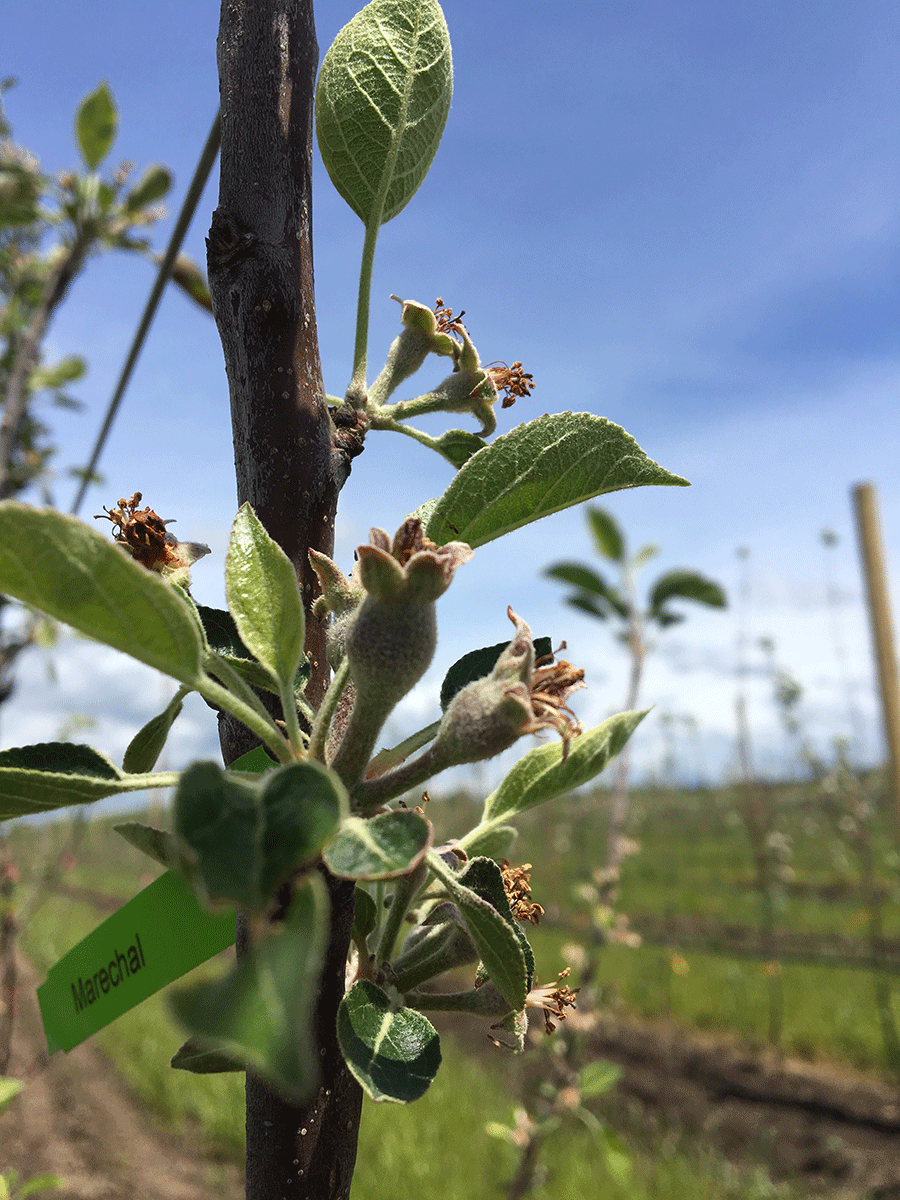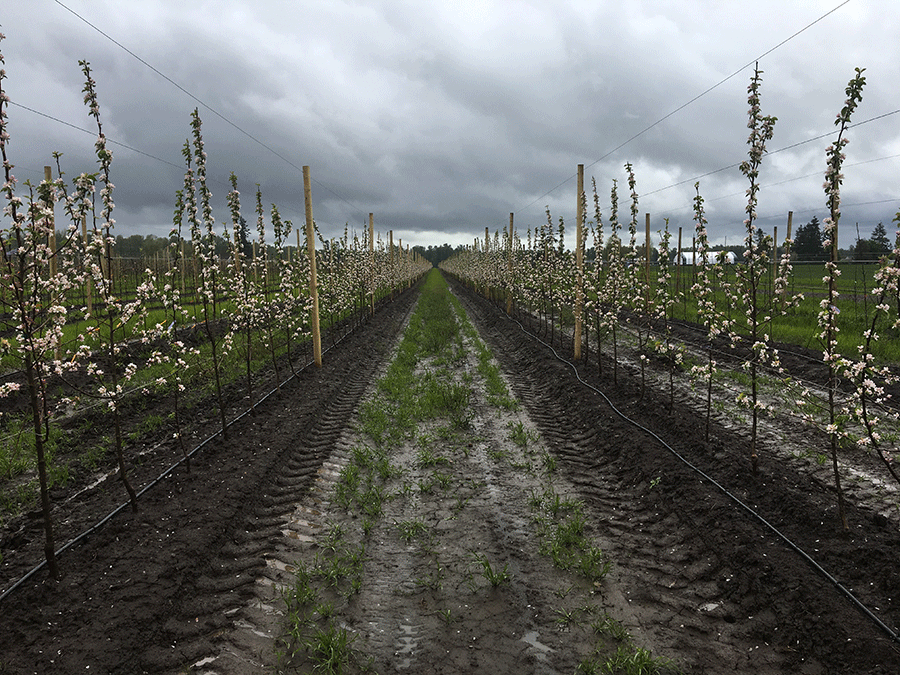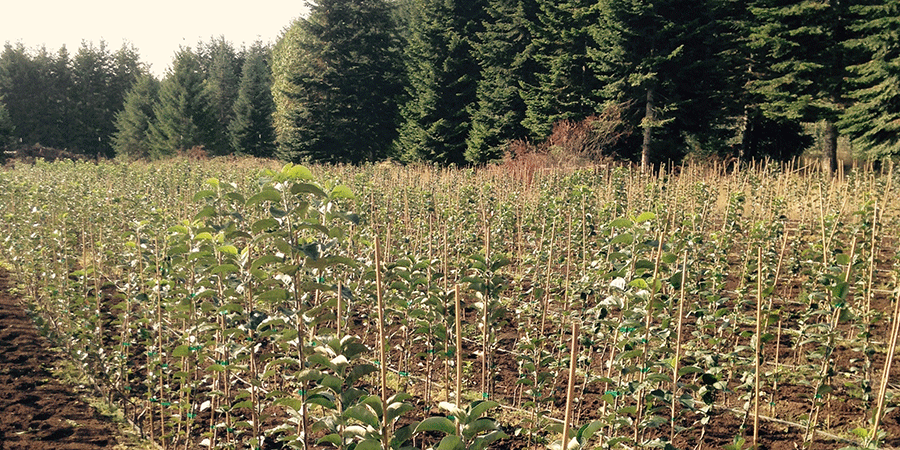-
Aug 01 2017 Orchard Update
Orchard trees rebound! Patience and persistence paid off this summer. It took a while for the orchard trees to decide that they were satisfied with their new home, but by early July most species had fully leafed out and fruit spurs (for next year) appear to be multiplying rapidly. Still struggling with blind wood in some of the bigger species (which means lots of pruning this coming winter).
Also, despite our best hand-thinning efforts, we did not manage to remove all the fruit from our trees, and it looks like we are going to have a first small crop from several species (especially Vilberie, Dabinett, Yarlington Mill, Muscat de Bernay and Brown Snout).
A quick look at the orchard on August 1, 2017. (Video was made for a friend but thought I would share).
-
Jun 02 2017 Fruit Thinning
 Under instructions from wiser fruit growing minds than ours, we have decided to hand remove as much of the apple crop, which is surprisingly large, that has set on our trees. All that productive tree energy needs to go into getting fully established in their permanent home.
Under instructions from wiser fruit growing minds than ours, we have decided to hand remove as much of the apple crop, which is surprisingly large, that has set on our trees. All that productive tree energy needs to go into getting fully established in their permanent home. Here you can see that the fruitlets are pushing 1/4 inch size…time to thin! Bummer…would love to have kept the fruit this first year in the orchard.
-
May 23 2017 Transplant Shock, Ugh!
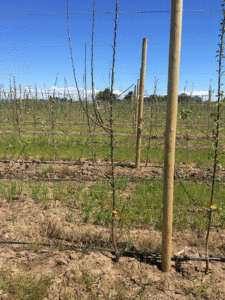
The trees we transplanted into our new orchard in late March have begun to leaf out, but they appear to be struggling, and the signs of normal mid-spring vigor are absent to some degree. Normal big, green, vigorous leaves look a little small, and many of the branches/feathers we worked hard to produce in the nursery are now mostly showing blind wood (no leaves or vigorously growing buds). Basically, it looks like the trees are suffering a bit of transplant shock.
We suspect that multiple factors lie behind this, with the wet conditions when we planted, with the large size of the nursery trees (many of them over 8ft tall), primary among these causes. Machine planting was efficient, but probably didn’t help given the wet conditions. Yes, we could have chosen to prune back many of the larger limbs, which would have lessened the stress on the roots to supply nutrients for such a large canopy. We’re hoping, however, that extended warm weather and regular watering (which should mellow out the soil) will help the trees recover to full vigor, push leaves (and fruit spurs!) where there is blind wood now, and encourage significant leader growth soon.
-
May 17 2017 Grafting Nursery Stock
We’re grafting several varieties (like Dabinett, Yarlington Mill and Kingston Black) that we already have in our existing orchard planting, along with numerous new varieties (for us), such as Calville Blanc d’Hiver, Marin Onfroy, Mettais, Bedan, Stoke Red, Somerset Redstreak, Michelin, Ashmead’s Kernel, Harrison, Domaine, etc.
Honestly wish the weather would have permitted us to graft these trees in early April, but we couldn’t even get the rootstock in the ground by then this year. Ground was just too wet. Hopefully, we can manage to get a good 4 feet of growth out of these trees.
-
Apr 13 2017 Planting New Nursery
You could probably say that we are gluttons for punishment. After all that work digging, hauling, storing and transplanting our cider apple trees, why in the world would we want to do it all over again — especially now that we’ve got our 12 acres of orchard trees in place and ready to go?
Answer: we’ve got 60 acres of ground we’re hoping to fill with cider apple trees (and eventually perry pears, too!). Given the high-density planting scheme we’ve selected, where our trees are on a 3-foot by 12-foot spacing, it takes about 1,200 trees just to fill one acre. That means we’re going to need 60 (acres) x 1,200 (trees/acre) to fill up this farm land completely, or a total of something like 72,200 trees. The 14,000 trees we’ve already got a just a drop in the bucket!
Here go the next 27,000 nursery trees!
-
Mar 13 2017 Orchard Planting
The weather in March has remained incredibly wet, even by Oregon standards – nearly another 7 inches more this month. After the ridiculously wet winter we’ve had, it’s hard to believe that the relentless, pounding rain just won’t let up.
Needless to say, this has caused us considerable headache in trying to get our orchard planted. We elected to heel in the trees, outdoors, in sawdust. The advantages were obvious: saving on cold storage and hauling costs, proximity to the orchard (right next door), to facilitate ease of planting, time and headache. However, we naively assumed that we would have a break in the weather sometime in February or March sufficiently long to dry out the wet ground and allow us to plant.
It didn’t happen. The rain kept coming in copious amounts. The rain didn’t stop the weather from gradually warming up and, of course, the days (and the sunlight) have grown longer. Together these pushed some of our trees out of dormancy and woke them up. The last place we wanted to trees to be when they broke dormancy was still in the sawdust…
So, as we watched and hoped for some dry weather, and as more of our cider tree species decided it was time to start growing again, we were forced with a choice: plant in wet conditions (which most fruit tree specialists will tell you is a bad idea) or wait and risk the trees leafing out even more (and suffering more transplant shock in due course).
We finally threw in the towel and started to plant around March 20. We’d plant for a day, then wait a day or two more for the next bout of rain to stop…but the ground was definitely WET. The job was complete by the end of March. Hoping that the wet planting conditions are not going to set our trees back too much this first season in the orchard.
Learn More!
-
Feb 10 2017 Building our Temporary Barn
We decided, arguably too late, that the tiny old barn that came with this property was just way too small to accommodate all of the equipment we needed to manage our orchard (tractors, sprayers, mowers, tillers, fruit bins, etc). What to do? How does one erect a large enough building, on a tight budget, in a few short weeks between nursery digging and orchard planting, while the mother of all rainy winters rages on and on?
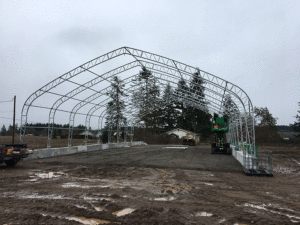
Despite the obstacles, we opted to purchase a large 5000 square foot tension fabric structure and put it up at the new orchard site in February. It was a wet, and sometimes frustrating experience, but we got it done. At least now we can rest assured that, for the next few years while we get the orchard up and running, we’ll have a big enough building for our needs. Have a look!
-
Feb 01 2017 Heeling in Nursery Trees
We hauled our trees, more than 12,000 of them, halfway across the Willamette Valley to our new orchard site near Stayton. The logistics of move the trees were daunting enough alone, but with the orchard ground still too wet to allow us to transplant the trees, we’ve decided to store them outdoors on site while we wait for dry weather to plant.
This has required us to bring in five large truckloads of sawdust so that we can heel the trees in, i.e., keep their roots well covered and moist.
With all of the trees now heeled in, we need a(nother) sustained break in the weather to make the orchard planting possible. More than anything, we’re hoping we can get this done before mid-March, when some of the early varieties (think Wickson, Reines des Pommes, and Golden Russet) decide it’s time to break dormancy.
-
Jan 27 2017 Nursery Dig
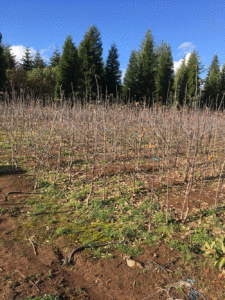
Fall/Winter this year in the Willamette Valley has been perhaps the wettest on record. In October alone, which marks the beginning of our rain year, we had more than 11 inches of rain; by the end of January over 27 inches of rain had fallen in 4 months. The relentless rain and resulting mud made it nearly impossible to dig up our nursery trees – we’ve been waiting endlessly for a break in the rain to last long enough to dry the ground and give us enoughdays to get the trees out (we needed 4 or 5 days to complete the dig).
By the last several days of January we got the break we needed, unbelievably considering the circumstances, and the dig started. We have hired a nearby professional nursery to dig the trees for us with their mechanical digger, since digging so many trees by hand would arguably be lunacy.
Have a look!
-
Jul 12 2015 Nursery Update – Summer 2015
Our cider apple trees are in their first year of growth, in a nursery (not orchard) setting. We grafted these trees (mostly) in April 2015 and have enjoyed watching them grow. We have grafted more than 15,000 trees (on dwarfing rootstocks) in 20+ traditional English, French and American cider varieties, such as Dabinett, Yarlington Mill, Brown’s Apple, Sweet Coppin, Brown Snout, Marie Menard, Reines des Pommes, Vilberie, Marechal, Porter’s Perfection, Golden Russet, Amere de Berthecourt, and so on.
Why in the world would we do this ourselves? We’re talking about 15,000 trees! Not exactly your hobby backyard nursery. Short answer: we tried, but were unable to find a commercial nursery that would do this for us – with so much scion wood (not verified virus free, etc), so many species to manage, etc. Maybe we didn’t look hard enough (we talked to 9 or 10 fruit tree nurseries)? Anyway, since we couldn’t find a “pro” to do it for us, we decided to take the plunge and do it ourselves.
Hoping for great results, and so far, things are looking good.

